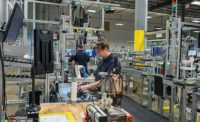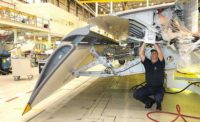Companies across a wide range of segments are adopting Industry 4.0 technology at a rapid pace, turning the next-generation vision of manufacturing—the Factory of the Future—into reality. Many of the advances in this transformation have been in highly automated industries, such as vehicle manufacturing. Conversely, the aerospace industry, with its staged approach to assembling aircraft, satellites and other products, has only just begun to investigate how Industry 4.0 technologies can improve operations, throughput, quality control and cost.
Whether it’s satellites, drones or commercial aircraft, aerospace production requires a combination of labor-intensive manufacturing and precision assembly of ultra-complex products. Compared to other industries, this workflow is unique. Airplane wings, for example, may require thousands of holes to be drilled with high accuracy in complex, fragile surfaces. In the automotive industry, it is estimated that close to 90 percent of drilling is automated, with only about 10 percent of drilling operations being done manually. In the aerospace industry, the situation is almost the exact opposite. And, since aircraft are produced under exceptional regulatory oversight for safety and quality control purposes, there needs to be detailed documentation of every part and every action as material flows through final installation, quality check and completion.
Industry 4.0 technologies are ideal for solving many of these challenges. More aerospace manufacturers and their suppliers are interested in making the journey to implement Factory of the Future concepts. However, many are unsure where to begin.
Setting a Foundation
In the Factory of the Future, intelligent Industry 4.0 technology connects everything, from individual machine components and workstations with embedded sensors, up through machine-level and plant-level communications architectures to cloud-based software. Sophisticated software collects, transfers and processes data in ways to provide both production transparency and actionable answers to questions about production bottlenecks, inefficient workflows and equipment in need of preventive maintenance.
With many major aerospace manufacturers having eight to 10 years’ worth of orders in their books, they need to keep their operations running without major disruption while still solving the demands for tomorrow. For aerospace manufacturers seeking to implement this kind of technology now, without sacrificing productivity or quality control, there are several key steps to consider when identifying where and how to begin:
- Lean principles: Industry 4.0 technology works best when the company adopting it has well-established lean principles and processes.
- Technology integration: Integrating smart tools and sensors into assembly systems is a simple, yet highly effective way to begin transformation.
- Data collection: With smart tools and sensors generating data, it’s important to address questions like what data do you need to achieve real change, where should the data go, and what do you do with it?
- Data analysis and visualization: Having data alone is only half the challenge—analyzing and visualizing that information in real time is just as crucial.
- Machine learning: As Industry 4.0 devices grow smarter, they can share more data, bringing more flexibility and improved overall equipment effectiveness to the factory floor.
- Artificial intelligence: The ultimate achievement in Industry 4.0 is when machines can predict their own futures and prevent downtime.
Start With Lean
To begin the journey to the Factory of the Future, aerospace companies should have a multiyear vision for transforming their operations. Then, based on that vision, the company can build a roadmap that identifies the “low-hanging fruit”—the initial, most glaring issues that lead to waste, inefficiencies or errors.
Effective use of Industry 4.0 technology depends on an established, lean manufacturing culture. Lean emphasizes eliminating waste, implementing continuous improvement processes (CIP), and improving the flow of material, people and information. For example, smart workstations have been shown to reduce errors in industries using manual assembly. This is a relatively cost-effective investment to begin with and can be guided by lean principles targeting waste and error in manual assembly.
Companies that have strong lean programs will be able to implement effective CIP programs that empower everyone across a production workflow to identify areas that are causing problems and propose ways to fix them.
Technology Integration
One of the unique anomalies of aerospace manufacturing is how it transitions from automated to manual production. Many initial components are fabricated in highly automated machining or manufacturing systems. These systems are already Industry 4.0-enabled with integrated sensors and PLCs that capture and package production data for analysis and quality control.
As subassemblies are created and installed, final assembly and integration is much more manual. For example, the final tightening of thousands of fasteners on aircraft is often done with pneumatic and manual wrenches that are purely mechanical, with manual inspections and written verification on paper documents. However, aerospace manufacturers can improve this process by integrating smart, programmable tightening tools that document the amount of torque applied for each fastener and that can automatically reconfigure torque and rotation settings based on the assigned task.
There are also Industry 4.0 assembly workstations that mix automated and manual systems using technology to better connect and support operators, machinery and parts to make flexible production easier. For example, at these workstations, each worker has a name tag with an embedded radio frequency identification (RFID) tag. The workstations are programmed to read the RFID tags and autonomously adapt the workplace to that worker’s skills and preferences. This includes ergonomic adjustments, such as changing the height of the work surface. The RFID tag can also connect with workflow management systems to initiate material requests or assembly instructions on behalf of the worker. All subassemblies made on these workstations have a unique identification tag. As the products move from station to station, the subassembly’s RFID tag is closely monitored by the production control system to trigger replenishment of components when necessary. Additionally, product carts are identified by RFID tags, and they alert automatic guided vehicles to automatically pick up materials for the next assembly cycle.
Ultimately, these intelligent tools can generate data to virtually assemble a “digital twin” of each aircraft, with documentation about the precision and quality of every weld, fastener and electrical connection. This can be delivered to the aircraft’s purchaser and to regulatory authorities as needed to validate the quality of the production.
Improving Data Collection
As smarter assembly tools are integrated into assembly processes, they also begin generating valuable data the entire company can use for CIP. All this new data presents a challenge: how to intelligently manage it to improve operations and further along the Industry 4.0 roadmap.
Companies that seek to upgrade their production systems by incorporating intelligence and sensors into multiple process points and connecting their machines should use their roadmap and lean principles to determine what functions or process points to measure in the first place to make full use of their technology investment.
An Industry 4.0 tool that is being adopted by many manufacturers, especially those with multiple plants or multi-tiered supply chains, is an Industry 4.0 gateway or Internet of Things (IoT) gateway. This gateway is a hardware and software platform that operates as an adjunct to process control logic, making it easier to connect production lines to the IoT. Gateways enable IT applications to collect sensor and process data, transmit it to manufacturing execution systems, cloud applications or local machine monitoring systems, and perform data analysis.
With these gateways, plant management can identify problem areas that normal human observation and evaluation might not capture. Using this data, product performance management or product quality management software can compare similar production operations across an entire aircraft assembly plant. They can even access cloud computing to compare performance factors across different plants in different global locations.
Analyzing Real-Time Data
In some aerospace assembly operations, the process of scheduling and tracking parts and materials from suppliers and subcontractors is still not digitized, nor is the process of monitoring how quickly those parts and materials are being used. For example, in some facilities, when different electrical systems are installed by different crews on the same aircraft, their progress is tracked manually on multiple whiteboards scattered around the plane.
In other industries, such manual systems have been replaced with digital kanban systems that provide more complete, real-time data. This data is organized and presented in a highly informative, visual fashion to track progress and assure that materials and work teams have what they need for each point in the work shift.
These interactive communications platforms process and visualize production data in real time and can network with plantwide IT applications, such as production planning, quality data management and email. They also provide an invaluable tool for start-of-shift quality huddles, helping production teams quickly identify and solve material and workflow issues based on actual data vs. historic data.
For example, at Bosch Rexroth’s Multi-Product Line (MPL) assembly operation in Bethlehem, PA, the company implemented a full-scale manufacturing center using its own Industry 4.0 technology portfolio. A key element in the MPL is an ActiveCockpit system to visualize production data from every area of the plant on a large screen. Employees can also access the information from mobile devices, laptops or tablets. Since operators and managers can access the information from anywhere in the plant, ActiveCockpit can alert them of a problem, allowing them to take corrective action immediately, reducing downtime and minimizing error.
Step-by-Step Into the Factory
These initial steps demonstrate the incremental investments in Industry 4.0 technology that can be made for a wide range of aerospace production workflows without significant disrupting current processes and systems.
As more and more smart systems are connected across the assembly floor, the next step—machine learning—can be developed. When connected devices can communicate, they can combine their tasks into logical, automated sequences, so personnel no longer have to tell machines what to do.
The most advanced step—artificial intelligence—offers the largest return on investment, when production systems can predict their own future before downtime can occur. These last two steps are higher-level goals for aerospace manufacturers, but they are goals to work toward once smarter systems generating useful data are fully woven into the production environment.
As incremental additions of smart systems are integrated across different aerospace workflows, data will become available in real-time, and can be collected and analyzed to further guide and improve each manufacturer’s Factory of the Future roadmap. By identifying Industry 4.0 technology that can be applied today, aerospace manufacturers can better position themselves for tomorrow, step-by-step.







